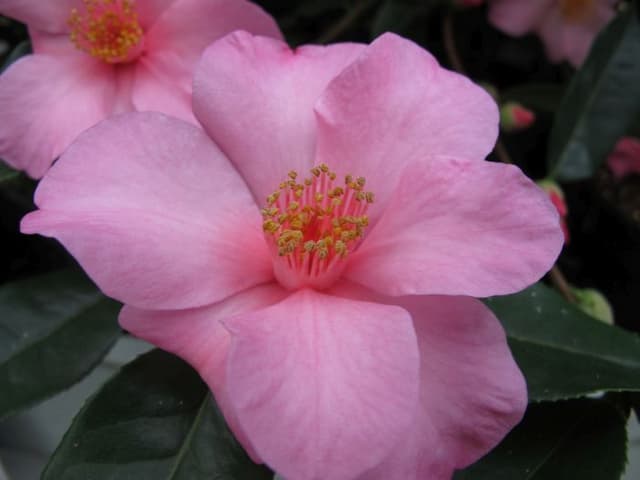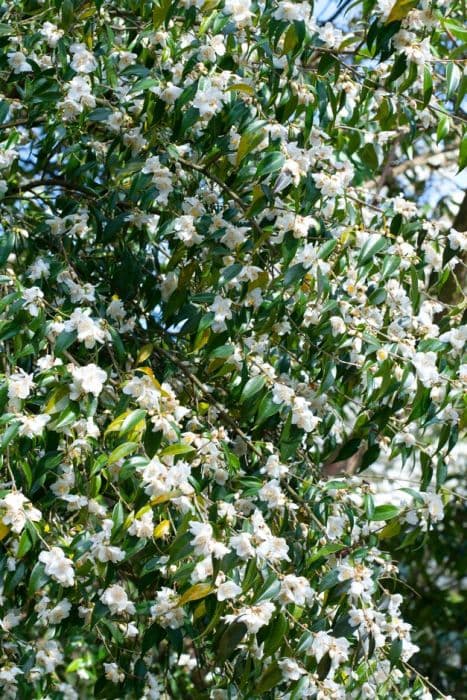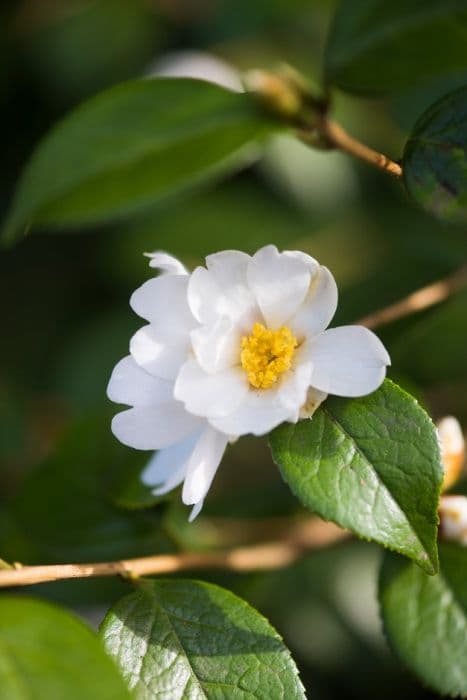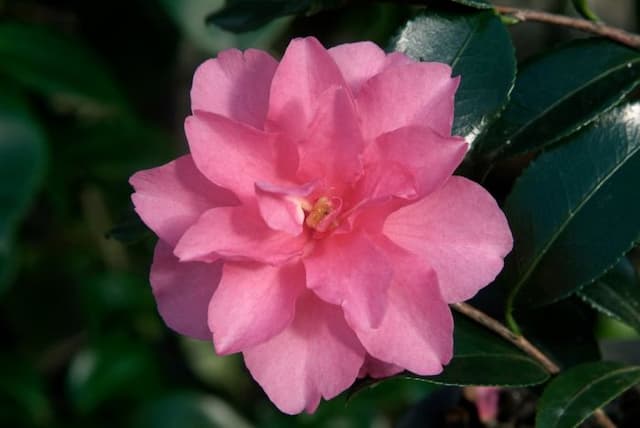Sasanqua Camellia Camellia sasanqua 'Mignonne'

ABOUT
The camellia, specifically the 'Mignonne' variety, is an evergreen shrub that is noted for its beautiful and ornate flowers. The blooms of the 'Mignonne' camellia are typically a soft pink shade, with a hint of deeper pink at the edges, creating a delicate gradient effect. The petals are arranged in a formal double bloom, meaning they are layered and numerous, giving the impression of a sophisticated and full blossom reminiscent of a peony or garden rose. The leaves of the camellia 'Mignonne' are glossy, dark green, and have a leathery texture with a slightly serrated edge. They provide a lustrous backdrop to the flowers and stay attractive throughout the year, preserving the shrub's aesthetic appeal regardless of the season. This variety of camellia usually produces its sumptuous blooms in the fall to winter season, offering a burst of color during a time when many other plants are dormant. The flowers are known for their longevity and can persist on the plant for several weeks. While the focus is not on the dimensions of the plant, the overall shape of the camellia 'Mignonne' is a rounded form with a dense habit, making it a popular choice for use as a decorative element in gardens. Its appearance lends itself to various landscaping needs like foundational plantings, hedges, or even as an eye-catching specimen thanks to its attractive foliage and striking flowers.
About this plant
 Names
NamesFamily
Theaceae
Synonyms
Sasanqua Camellia, Christmas Camellia, Winter Camellia
Common names
Camellia sasanqua 'Mignonne'.
 Toxicity
ToxicityTo humans
The plant commonly known as Sasanqua Camellia is not considered toxic to humans. There are no well-documented cases of poisoning from ingesting parts of this plant. Therefore, there are no specific symptoms of poisoning or adverse consequences associated with this plant in humans when it comes to toxicity.
To pets
Sasanqua Camellia is generally not considered toxic to pets. It does not appear on the list of poisonous plants for pets maintained by organizations such as the ASPCA (American Society for the Prevention of Cruelty to Animals). Therefore, there should be no symptoms of poisoning or toxic consequences in pets such as cats and dogs from ingesting parts of this plant.
 Characteristics
CharacteristicsLife cycle
Perennials
Foliage type
Evergreen
Color of leaves
Green
Flower color
Pink
Height
4-5 feet (1.2-1.5 meters)
Spread
5-6 feet (1.5-1.8 meters)
Plant type
Shrub
Hardiness zones
7
Native area
Japan
Benefits
 General Benefits
General Benefits- Ornamental Appeal: Camellia sasanqua 'Mignonne' offers aesthetic beauty with its delicate pink flowers and glossy green foliage.
- Long Blooming Season: It typically has a prolonged flowering period from fall to winter, adding color to gardens during a time when many other plants are dormant.
- Compact Size: With a relatively small growth habit, this plant is suitable for smaller gardens or limited spaces.
- Privacy Screening: Its dense growth makes it an excellent choice for creating privacy hedges or screens in landscaping.
- Low Maintenance: Once established, it requires minimal care, making it a convenient choice for gardeners of all levels.
- Drought Tolerance: It is relatively drought-tolerant once established, reducing the need for frequent watering.
- Adaptability: 'Mignonne' can adapt to a range of soil types, though it prefers acidic, well-drained soil.
- Versatility in Landscaping: It can be used in various landscape designs, including as a specimen plant, in mixed borders, or in container gardens.
- Attracts Pollinators: The flowers can attract bees and other pollinators to the garden, supporting local ecosystems.
 Medical Properties
Medical PropertiesThis plant is not used for medical purposes.
 Air-purifying Qualities
Air-purifying QualitiesThis plant is not specifically known for air purifying qualities.
 Other Uses
Other Uses- Sasanqua camellia petals can be used as a colorful garnish for salads and desserts, adding a vibrant touch to the presentation.
- The leaves of the sasanqua camellia can be dried and used as a substitute for tea leaves in homemade tea blends for a unique flavor.
- Camellia sasanqua petals are sometimes used in the art of flower pressing, creating beautiful and lasting artwork.
- The high-quality oil extracted from the seeds of sasanqua camellia is traditionally used for protecting and maintaining the blades of tools and knives.
- Camellia sasanqua's dense foliage can be trimmed into intricate shapes for topiary art, providing a creative aspect to gardening.
- The wood of sasanqua camellia is hard and can be used in the crafting of small wooden objects such as handles, ornaments, or inlay work.
- When dried and infused, sasanqua camellia flowers can add a delicate scent to potpourris and natural homemade cosmetics.
- The flower's waxy texture allows it to be used in candle making, either as a decoration or to lightly scent the wax.
- Camellia sasanqua seed oil, due to its stability, is used as a lubricant for precision machinery and watches.
- The petals can be used to create natural dyes for fabrics, yielding soft colors that are eco-friendly and subtle.
Interesting Facts
 Feng Shui
Feng ShuiThe Sasanqua Camellia is not used in Feng Shui practice.
 Zodiac Sign Compitability
Zodiac Sign CompitabilityThe Sasanqua Camellia is not used in astrology practice.
 Plant Symbolism
Plant Symbolism- Longevity: The Camellia sasanqua, commonly known as Sasanqua camellia, is often associated with longevity due to its long blooming season and hardiness.
- Love: Camellias are commonly seen as a symbol of love, with their lush flowers and rich colors conveying deep affection and adoration.
- Admiration: Sasanqua camellia blooms represent admiration, which is conveyed through their delicate petals and elegant presence.
- Perfection: The perfect form of their flowers symbolizes perfection, making them ideal for conveying a message of flawless beauty or excellence.
- Gratitude: In some cultures, the camellia flower stands for gratitude. Giving a camellia can be a way of expressing thanks or appreciation for someone.
 Water
WaterSasanqua camellias like 'Mignonne' prefer evenly moist soil; therefore, it's important to water them deeply. Water the plant with about 1-1.5 gallons once a week, but adjust the frequency depending on weather conditions—more frequently during dry spells and less during rainy periods. Ensure the soil is well-draining to prevent root rot. During the winter, reduce watering but do not allow the soil to completely dry out.
 Light
LightSasanqua camellias, including 'Mignonne', thrive in partial shade. The ideal location would receive morning light and be protected from the intense afternoon sun. An eastern or northern exposure would be ideal, providing the gentle light that these camellias need without the harsher sun that can scorch their leaves.
 Temperature
TemperatureSasanqua camellias like 'Mignonne' are cold hardy and can withstand temperatures as low as 10°F but perform best in temperatures ranging between 68°F and 72°F. Avoid exposure to temperatures above 85°F, as excessive heat can cause stress and impact blooming. They prefer a moderate climate and should be protected from harsh winter winds.
 Pruning
PruningSasanqua camellias like 'Mignonne' are pruned to maintain shape, remove dead or weak growth, and encourage flowering. Prune immediately after blooming ends, typically late winter or early spring. Cut back to just above a set of leaves for best results, and thin out the interior to improve air circulation.
 Cleaning
CleaningAs needed
 Soil
SoilSasanqua camellias thrive in well-draining, acidic soil with a pH between 5.5 and 6.5. A recommended soil mix for Sasanqua camellias is 1/3 pine bark, 1/3 peat moss, and 1/3 perlite or vermiculite, which ensures good drainage and aeration.
 Repotting
RepottingSasanqua camellias should be repotted every 2-3 years or when they become root-bound. It is best to repot in the spring just before the growing season begins.
 Humidity & Misting
Humidity & MistingSasanqua camellias prefer moderate to high humidity levels. Aim for humidity between 40% and 60% to keep these camellias thriving.
 Suitable locations
Suitable locationsIndoor
Place Sasanqua camellias in bright, indirect light and ensure high humidity.
Outdoor
Plant in partial shade, shelter from strong wind, mulch well, water regularly.
Hardiness zone
7-9 USDA
 Life cycle
Life cycleCamellia sasanqua 'Mignonne', commonly known as Sasanqua Camellia 'Mignonne', begins its life as a seed that germinates in well-draining acidic soil, typically in early spring. The seedling stage follows, where the young plant develops true leaves and a stronger root system. As the plant matures into a vegetative state, it develops woody stems and evergreen foliage, growing slowly but steadily. This Camellia species typically enters a blooming stage in the fall to winter months, exhibiting delicate pink flowers that attract pollinators. After pollination, it produces seed pods which mature and eventually open to release seeds, completing its reproductive cycle. Throughout its life, the Sasanqua Camellia can be pruned and shaped, which is commonly done after the flowering stage to maintain its desired appearance and encourage healthy growth for the following season.
 Propogation
PropogationPropogation time
Early spring
Camellia sasanqua 'Mignonne', commonly known as sasanqua camellia, can be propagated most effectively through semi-hardwood cuttings. This method is typically done in late summer after the new growth has begun to mature and harden slightly. To propagate, a cutting about 4 to 6 inches (approximately 10 to 15 cm) long is taken from a healthy, disease-free parent plant. The leaves on the lower half of the cutting are removed, and the cut end may be dipped in rooting hormone to enhance root development. The prepared cutting is then placed in a well-draining potting mix, ensuring at least two nodes are buried where leaves were removed. The pot should be kept in a warm, humid environment, out of direct sunlight, and the soil kept moist until the cutting has rooted, which can take several weeks. It's important to provide a stable environment to encourage rooting without causing the cutting to rot.









